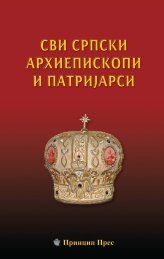Monografija - prvo izdanje - niska rezolucija
You also want an ePaper? Increase the reach of your titles
YUMPU automatically turns print PDFs into web optimized ePapers that Google loves.
Јелена је била једна од најомиљенијих српских<br />
краљица, крштена као католкиња, прешла је у пра вослав<br />
ље, а по да ро ви ма памте је и православни монаси,<br />
и католички ред бенедиктанаца. Краљица Јелена једн а<br />
је од ретких немањићких краљица која је имала важну<br />
уло гу у државној политици и култури Србије. Чак јој<br />
је, после смрти мужа, Уроша Првог, додељена посебна<br />
об ласт на управљање. Била је мудра, образована, предузимљива.<br />
Поштовали су је и католици и православни.<br />
Иако је по доласку у Србију променила веру, одржа<br />
вала је контакте са католичким светом. Градила је<br />
католичке цркве по Приморју, помагала бенедиктанце и<br />
фрањевце, дописивала се са папом, који јој се обраћао<br />
са „својом у Христу најми ли јом ћерком”.<br />
Истовремено, ар хи епи скоп Данило хва ли ње ну<br />
побожност и ода ност православној црк ви помињући<br />
„бога те да рове које је слала Све тој Гори”.<br />
Остало је записано<br />
како је окупљала си ромаш<br />
не српске девојке, ос -<br />
нивајући неку врсту де војачке<br />
школе.<br />
Кад је умрла, била<br />
је тако страшна зима, да је<br />
пренос њиних пос мрт них<br />
остатака у Градац обављен<br />
с великом муком: готово<br />
нико није присуствовао њеној<br />
сахрани.<br />
Све до половине 14.<br />
века, манстир Градац играо<br />
је важну улогу, био богат и многољудан. Не зна се шта се<br />
с њим дешавало у 15. и 16. веку. Црква је поправљена<br />
крајем 16. века. Тад је поново прекривена оловом, али<br />
фрескопис је, нажалост, највећим делом био уништен.<br />
Крајем 19. века над црквом је подигнута дрвена насте<br />
шница, да би се заштитила од даљег пропадања.<br />
По сле Другог светског рата, након 13 година радова<br />
на обнови, црква је реконструисана 1948. Срећом, оста<br />
ло је сачувано довољно елемената да јој се врати<br />
првобитан изглед.<br />
the Hellenistic ideal of beauty- the Queen’s taste and culture<br />
are seen purely in the architecture and frescos of Gradac.<br />
Jelena was one of the much-loved Serbian queens, baptised<br />
Catholic, she accepted orthodoxy, and both the Orthodox<br />
monks and the Catholic Benedictine order remember her<br />
for her donations. Queen Jelena is one of the rare Nemanjić<br />
queens who had an important role in state politics and the<br />
culture of Serbia. Even a specific territory was given to her for<br />
governing after her husband’s death. She was wise, educated<br />
and ambitious.<br />
Both Catholics and Orthodox Christians respected her. She<br />
continued her relation with the Catholic world even though she<br />
changed religion after moving to Serbia. She built Catholic churches<br />
at the seacoast, helped Benedictines and Franciscans, and had<br />
correspondence with the Pope, who addressed her as “my most<br />
loved Christian daughter”. At the same time, Archbishop Danilo<br />
praises her devoutness and loyalty to the Orthodox church mentioning<br />
“rich gifts she has sent to the Holy Mount Athos”.<br />
Манастирска црква пре<br />
почетка рестаурације<br />
Monastery church before<br />
the restoration started<br />
It was also written that<br />
she gathered impoverished Serbian<br />
girls and established some<br />
sort of girls’ school.<br />
When she died, the winter<br />
was so cold that the transfer<br />
of her bodily remains to Gradac<br />
was accomplished with great difficulty:<br />
almost nobody attended<br />
her funeral.<br />
Until the middle of the 14 th<br />
century, the Gradac monastery<br />
played an important role, was<br />
rich and had a large number of<br />
people. It is not known what was happening to the monastery<br />
during the 15 th and the 16 th century. The church was repaired<br />
at the end of the 16 th century. It was covered again with lead,<br />
and the fresco painting was already, to a large extent, unfortunately,<br />
destroyed. At the end of the 19 th century a wooden<br />
covering was built above the church in order to protect it from<br />
further damage. After the Second World War and thirteen years<br />
of renovation works, the church was reconstructed in 1948.<br />
Fortunately, an adequate amount of elements has been preserved<br />
in order to bring out the original appearance.<br />
111
















